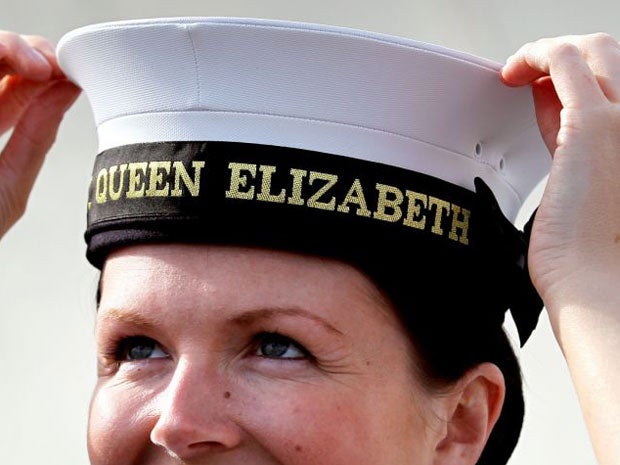HMS Queen Elizabeth aircraft carrier sets sail for sea trials
Royal Navy's largest and most powerful warship has been plagued by delays and cost overruns

Your support helps us to tell the story
From reproductive rights to climate change to Big Tech, The Independent is on the ground when the story is developing. Whether it's investigating the financials of Elon Musk's pro-Trump PAC or producing our latest documentary, 'The A Word', which shines a light on the American women fighting for reproductive rights, we know how important it is to parse out the facts from the messaging.
At such a critical moment in US history, we need reporters on the ground. Your donation allows us to keep sending journalists to speak to both sides of the story.
The Independent is trusted by Americans across the entire political spectrum. And unlike many other quality news outlets, we choose not to lock Americans out of our reporting and analysis with paywalls. We believe quality journalism should be available to everyone, paid for by those who can afford it.
Your support makes all the difference.Britain's largest and post powerful warship set sail for the first time today, after its construction was marred by delays and cost overruns, in addition to doubts over whether the Royal Navy will be able to afford the full capacity of fighters.
Naval staff and contractors lined the deck of HMS Queen Elizabeth as the 280-metre, 65,000-tonne aircraft carrier moved from Rosyth out into the Firth of Forth on Monday in a three-hour operation.
The behemoth, which is set to be the nation's future flagship, and her 700-strong ship's company will undertake her maiden sea trials over the summer.
The vast vessel's journey to sea was a major operation, where timing was key.
After waiting until high tide to leave the naval dockyard, the carrier then waited for the tide to drop so it could pass under the Firth's famous bridges.
Speaking before the maiden voyage, commanding officer Captain Jerry Kyd said: "We have to be very careful, but you practise it and drill it and rehearse it to make sure we could do it safely in a timely fashion because the tide waits for no man."
For the next six weeks, the aircraft carrier will head to the North Sea for sea trials, with flight trials due to begin off the eastern coast of the United States in October 2018.
It is expected to be monitored by Russian submarines, ships and planes.
Captain Kyd said: "After that we're going back out for a further three weeks to test the ship on the more war-fighting capabilities - the radars, all the ship's sensors, radios and things like that.
"At the end of that period we know that all the basics work. She's done her test drive and after that we will go down to Portsmouth, the ship's home, and get her finally ready to join the Royal Navy fleet, hopefully at the end of the year."
She is scheduled to be operational by 2020.


But the HMS Queen Elizabeth has faced significant setbacks during its construction.
The ship has taken more than eight years to build at a cost of £3.5bn.
The Royal Navy's second new carrier, the Prince of Wales, will follow in two years' time, and together the ships will cost over £6bn - making them the most expensive project in the Navy's history.
Although each carrier can hold 36 F-35B stealth jets and four helicopters, there are concerns the defence budget won't allow the Navy to put a full complement of fighters on board.
To meet the shortfall, the Royal Navy will allow the US Marines to fly their own F-35Bs from the carriers, though the number is still under discussion.
Critics have also claimed the carriers are too vulnerable to new high-speed missiles, such as the Russian Zircon missile.
During her estimated 50-year working life, HMS Queen Elizabeth could be pressed into action for various work such as high intensity war fighting or providing humanitarian aid and disaster relief anywhere in the world.
Join our commenting forum
Join thought-provoking conversations, follow other Independent readers and see their replies
Comments